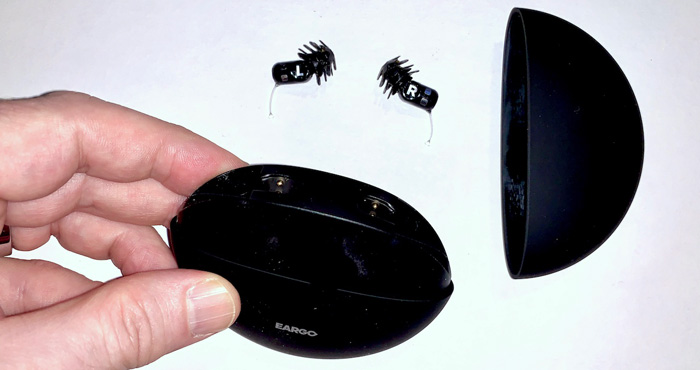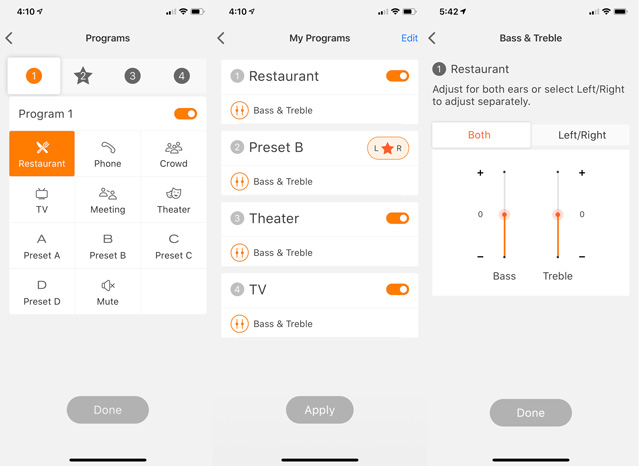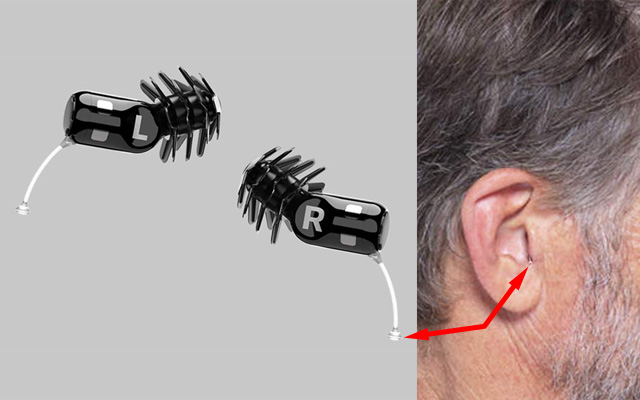We may earn commissions when you buy from links on our site. Why you can trust us.
Review of the Eargo Neo HiFi

Hearing loss is a slow process. But when you realize that you are turning on the closed captioning a bit more frequently so you can follow the dialog and struggling to hear conversation over the dinner table, it is time to consider getting a hearing aid, like the discreet barely-there Eargo Neo HiFi.
The Eargo Neo HiFi is a certified Class 1, FDA-regulated medical device intended for individuals with mild to severe high-frequency hearing loss (made legal in the Over the Counter Hearing Aid Act in August 2018). At just under $3,000, it sits in between prescription hearing aids, which are usually priced well north of $6,000, and most over-the-counter (OTC) hearing aids, which usually cost a few hundred dollars. Like with other OTC hearing aids, you do not need to work through an audiologist to buy the Neo HiFi via a prescription. But unlike other OTC devices, your purchase does include a virtual consultation with an audiologist to help you get set up and correctly using the Neo HiFi.
So how well does the Neo HiFi work? I’ve been covering and testing hearing aid alternatives, including the new over-the-counter (OTC) solutions, for more than a decade. In my testing, I found the Neo HiFi to be discreet and easy to wear, and to be the best sounding and highest-value over-the-counter hearing aid available.
Design and ergonomics of the Eargo Neo Hifi
Each black Neo HiFi bud is around three-quarters of an inch long, a smidge less than an eighth of an inch thick, and barely weighs anything worth mentioning. The buds are stored in a circular black charging case, three inches in diameter and 7/8 of an inch thin, so eminently pocketable. You charge the case and the buds via an included USB-C cable – no need to buy batteries! The buds will operate for around 16 hours, and the charging case stores a week's worth of power. Thirty minutes of quick charging provides a couple of hours of hearing boost.

Inside the box are some accessories. These include:
- three pairs of additional "flexis" – flange skirts that determine how much external sound enters your ear
- 16 replaceable wax guard rings with a replacement tool
- a brush to daily clean ear wax off the speaker grills, the flexis and the battery contacts
- a USB charging cable and AC transformer
Setting up the Eargo Neo HiFi
When you buy the Eargo Neo HiFi, you receive a setup call – which can be a video call – with one of the company's nearly three-dozen staff hearing professionals, both audiologists and board-certified hearing instrument specialists. This welcome call is not an audio test or a hearing examination. Instead, you are guided through caring for the Neo HiFi, accessories use and replacement, and setting up the Neo HiFi so each bud suits your specific hearing issues via the app.
The app is complicated. When you're wearing your Neo HiFi buds, you can toggle through four different numbered programs – 1, 2, 3, 4. You can choose from six "soundscape" programs: restaurant, phone, crowd, TV, meeting, and theater, along with mute. There are also four, lettered preset modes – A, B, C, D. Each of these sound programs include sliding bass and treble controls that can be adjusted for both ears at the same time or each ear separately to compensate for those who hear differently in each ear. To toggle sequentially through each of the four programs when you're wearing the Neo HiFi buds, you double-tap each ear (each ear has to be double-tapped separately to change the preset).

If all this sounds confusing, it is. Even after the guided set-up with my assigned Eargo audiologist (Dr. Jennifer Neary of New Paltz, NY) and playing with the numbered and lettered settings, I still don’t understand the difference between the named soundscape programs and the four, lettered presets.
You can't adjust the soundscape program when the Neo HiFi buds are in your ears, only when the buds are in the charging case. That means you have to memorize your four program presets and their sequence – when you tap your ears twice, the voice prompt tells you the program preset number (i.e. "Program 3") rather than the soundscape name (i.e. "Restaurant").
Each of the included fringed flanges are slightly different and provide different aural experiences. Your Eargo audiologist will walk you through the hows and whys. You can then experiment with the different flanges based on your unique hearing characteristics, along with the app preset programs to get to your optimal flange and soundscape program configuration.
While the soundscape programs are confusing, they’re worth exploring. Some programs offer a wide soundstage to pick up more ambient noise (good for the theater and other crowded spaces), others offer a narrow soundstage for more intimate dialog-centric personal situations, such as dinnertime conversation and watching TV. For further fine-tuning, you can set bass and treble levels for either both ears or each ear individually. You just have to experiment, remembering you have to change the soundscape settings while the buds are still in the case, which makes for awkward and time-consuming preset comparisons. Dr. Neary told me the app could be set up remotely if necessary.
Eargo's Tarrytown, NY-based audiologist Dr. Jennifer Gilligan asserts that "the main goal of hearing aids is to make speech more clear," which is when Neo HiFis’ no-fuss default preset excels.
If you need additional assistance, Eargo offers free on-going help sessions via phone, text or web chat, that can be scheduled online.
Using the Eargo Neo HiFi
You don't insert as much as lay the Eargo Neo HiFi buds on the inside edge of your ear canal. A thin, tiny tail lays under/behind the notch tragus – that small fleshy tab that guards the front of your ear canal – that makes it easy to grab the bud to insert and remove it.

When you first insert the buds, they tickle a little, at first. But after around 10 minutes, you forget you're even wearing them. That is, except when eating. I found that the natural jaw movement while chewing causes the buds to tickle my inner ear a bit during meals.
Sounds are instantly amplified to nearly twice the volume you normally experience them. Suddenly you hear noises you forgot existed. You'll hear creaking floorboards as you walk. A flipped light switch sounds like a gunshot. Running water from a faucet sounds like the whoosh of a waterfall. All these noises suddenly sound alien. "Your brain hasn’t heard these sounds in so long, it has learned to ignore them," Dr. Neary explained. "Normal hearers hear their foot sounds, and northerners hear crackling leaves – these are sounds you didn’t know you were missing."
But Neo HiFi buds offer more than mere amplification. On its web site, Eargo claims that:
Life is better in surround sound. We fine-tuned Eargo Neo HiFi to deliver a listening experience that would please even the pickiest of audiophiles. Featuring our best noise reduction and feedback cancellation, plus more added stable gain, Eargo Neo HiFi lets you experience sound just as nature intended. Who are we kidding? It’s better than nature intended.
This is not entirely marketing hyperbole. It only takes a couple of minutes to get used to the feel of the Neos in your ear and the unaccustomed and slightly artificial-seeming sounds they produce. Within about 15-30 minutes, you're likely to completely forget you're wearing them. All of a sudden, you discover your environment just sounds – normal. Louder, clearer, but normal. You may get an urge to itch your ear at some point, only to be surprised that the Neo is in the way – that's how natural they feel.
For some, getting used to the Neos might take longer. "Things could sound tinny and your voice could sound robotic," Dr. Neary warns. "Give yourself some grace along the way. It may take a couple of weeks while your brain adapts."
Perhaps best of all, they don't squeal unless you or someone else covers or cups your ear.
Maintenance of the Neo HiFi
Eargo suggests you remove and clean the flexi flanges every six months; you can buy three more pairs for $25. Wax guards should be replaced when sound starts getting dull. Once you've used the included 16 – eight pair, you buy extra packs at $25 a pack. Eargo also recommends you get your ears cleaned every three-to-six months.
You will want to brush off ear wax, perhaps daily, especially from the speaker grill, the tiny rear microphones, and the battery contacts so the buds charge properly. Unfortunately, the charging case doesn't accommodate the brush; I wish a small bag or pouch were included so the brush could be carried along with the charging case, or perhaps even magnetized so it could stick to the case.
The bottom line
Eargo Neo HiFi opens up new personalized audio experiences for the hearing impaired for far less money than traditional prescription hearing aids. They're light, easy to wear, and provide a wide variety of auditory assistance for a wide variety of environments – and no one will know you're wearing them.
Simplifying the program/preset settings and enabling the voice prompt to tell you which program you're using after you've double-tapped your ears would increase the ease-of-use immensely, which is why I subtracted a star. However, these are mere quibbles for what I found to be the best sounding and highest-value over-the-counter hearing aid available.
Available for $2,650 or $123/month on Eargo, check price on Amazon.
[Image credit: Stewart Wolpin/Techlicious, Eargo]
Stewart Wolpin has been writing about consumer electronics for more than 35 years, including news, reviews, analysis and history, and has attended and covered nearly 50 Consumer Electronic Shows and around a dozen IFA shows in Berlin. For more than a decade, he has been covering and testing hearing aid alternatives, including direct-to-consumer (DTC) and new over-the-counter (OTC) solutions.















From S.F. on October 26, 2020 :: 7:01 pm
I second all the writer’s complaints. I have only been wearing my Neo Hi-fis for a few days and I have experimented with the Soundscapes, the individual and the very limited equalizer style settings. Music-wise, these are definitely not hi-fi. Music becomes quite tinny at all the settings I have tried. I realize the goal of hearing aids is to help distinguish voices from background noise, but I am far from convinced these are the panacea I’d hoped for. I really don’t want to hear my coat sleeves rustle when I walk. It’s like wearing noisy corduroys, but also includes amplifying every page turning, drop of a pen on my desk, etc. More than I want to hear, frankly. Hopefully my brain and Eargo can modulate this to where I can stand it.
Reply